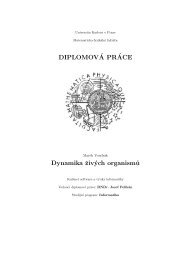Bachelor Thesis - Computer Graphics Group
Bachelor Thesis - Computer Graphics Group
Bachelor Thesis - Computer Graphics Group
Create successful ePaper yourself
Turn your PDF publications into a flip-book with our unique Google optimized e-Paper software.
1. the most naive idea is the user of a timer (QTimer or SetTimer), invoking<br />
a handler routine in periodic intervals. This procedure would determine<br />
the mouse cursor position (GetCursorPos) and check whether<br />
the individual mouse buttons are pressed (GetAsyncKeyState). This<br />
solution is very inefficient and unreliable. Events can be lost between<br />
two consequent polling intervals. However, the biggest and unavoidable<br />
shortcoming is the inability to filter mouse events, rendering this option<br />
useless<br />
2. the second idea is to use Raw Input API [23] introduced in Windows<br />
XP. After registering for input notifications by calling the RegisterRaw-<br />
InputDevices function, our application would receive WM INPUT<br />
events, generated directly by the mouse. However, there is the same<br />
critical problem that we are not able to filter these events<br />
3. DirectInput [19] is another option, although not a good one. It is<br />
primarily meant to be used in games. When initialized in the exclusive<br />
mode, our program would receive all the mouse input events, while no<br />
other application gets any. This is a bad idea. All the standard mouse<br />
messages supposed to be send by Windows would have to be generated<br />
manually and routed to the corresponding windows<br />
4. hooks [26] are the right choice. When set, a specified callback function<br />
will be called on every mouse input event. The function decides whether<br />
to swallow the message or pass it to the affected window. The first<br />
available hook type - WH MOUSE LL may seem to be the best as it<br />
does not involve a library injection. The callback function is located in<br />
the hooking application. Nevertheless, this means that context is being<br />
switched between the hooked and hooking application on every event.<br />
This makes this hook type quite inefficient. If used, every single mouse<br />
cursor movement would cause two extra context switches. Therefore,<br />
the second alternative, WH MOUSE hook type has been chosen as the<br />
final solution. A library containing the callback function is injected into<br />
the address space of all applications running in the current login session.<br />
The function is called directly before the message reaches the window<br />
procedure, hence no context switch is involved<br />
5. subclassing [25] has also been considered as a potential alternative to<br />
hooks. By replacing the original window procedure, we can process all<br />
messages including the mouse events and decide whether to pass them<br />
to the previous window procedure, effectively implementing a filtering<br />
mechanism. But this approach is very problematic, a library containing<br />
our window procedure has to be loaded into the target process by some<br />
kind of code injection technique [38, 8]. Separate procedure variants<br />
have to be written for both ANSI and Unicode window types. The<br />
window procedure has to be replaced for all windows separately. Another<br />
hook type - WH SHELL, would have to be used to detect new window<br />
creation<br />
21
















